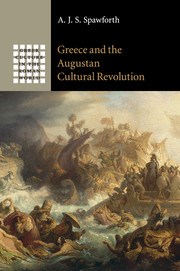Book contents
- Frontmatter
- Contents
- Illustrations
- Acknowledgments
- Chapter 1 Introduction
- Chapter 2 ‘Athenian eloquence and Spartan arms’
- Chapter 3 ‘The noblest actions of the Greeks’
- Chapter 4 ‘The gifts of the gods’
- Chapter 5 ‘Constructed beauty’
- Chapter 6 Hadrian and the legacy of Augustus
- Conclusion
- Bibliography
- Index
- References
Chapter 5 - ‘Constructed beauty’
Published online by Cambridge University Press: 05 November 2011
- Frontmatter
- Contents
- Illustrations
- Acknowledgments
- Chapter 1 Introduction
- Chapter 2 ‘Athenian eloquence and Spartan arms’
- Chapter 3 ‘The noblest actions of the Greeks’
- Chapter 4 ‘The gifts of the gods’
- Chapter 5 ‘Constructed beauty’
- Chapter 6 Hadrian and the legacy of Augustus
- Conclusion
- Bibliography
- Index
- References
Summary
Under Augustus parts of Greece experienced what can best be described as a building boom. In broadest terms the trigger for this wave of investment in public works was Octavian's victory at Actium: ‘a turning point in the history of the Greek world and of the Greek city which was at least as significant as the reign of Alexander’. What follows is not a general survey but an attempt to capture something of the ideological impulse behind this activity. Despite its image of poverty among ancients and moderns alike (see the end of this chapter), Augustan Greece experienced its own version of the transformations in the built environment marking the advent of the principate elsewhere in the empire. In the case of Greece a striking component of this activity was architectural restoration, so important in Roman times that ‘archaeology scarcely reveals anything but rebuilt cities’.
To put Greek developments in an ideological context, urbanism constituted a keynote of Augustan culture. In the Res gestae, in effect his political testament, Augustus goes out of his way to stress his role as a patron of public works in Rome and Italy. As an aspect of his pietas, he restores eighty-two templa deorum in 28 bc alone, along with the Capitol, and builds from scratch a further thirteen. His other restorations and new builds embrace a range of public buildings and amenities, among them bridges, aqueducts, a trunk road, theatres, administrative buildings and a forum. This huge programme – to which must be added the works of his son-in-law Agrippa and other members of the imperial family – was ideological as well as utilitarian in its motivation. As Vitruvius says, through the ‘eminent dignity’ of the new buildings was displayed ‘the majesty of the empire’. His own authorial project has been characterised as ‘the rebuilding of Roman identity through architecture’.
- Type
- Chapter
- Information
- Greece and the Augustan Cultural Revolution , pp. 207 - 232Publisher: Cambridge University PressPrint publication year: 2011



